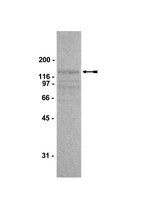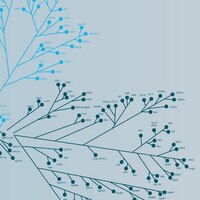c-Abl has high intrinsic tyrosine kinase activity that is stimulated by mutation of the Src homology 3 domain and by autophosphorylation at two distinct regulatory tyrosines.
Brasher, B B and Van Etten, R A
J. Biol. Chem., 275: 35631-7 (2000)
2000
Show Abstract
Using the specific Abl tyrosine kinase inhibitor STI 571, we purified unphosphorylated murine type IV c-Abl and measured the kinetic parameters of c-Abl tyrosine kinase activity in a solution with a peptide-based assay. Unphosphorylated c-Abl exhibited substantial peptide kinase activity with K(m) of 204 microm and V(max) of 33 pmol min(-1). Contrary to previous observations using immune complex kinase assays, we found that a transforming c-Abl mutant with a Src homology 3 domain point mutation (P131L) had significantly (about 6-fold) higher intrinsic kinase activity than wild-type c-Abl (K(m) = 91 microm, V(max) = 112 pmol min(-1)). Autophosphorylation stimulated the activity of wild-type c-Abl about 18-fold and c-Abl P131L about 3.6-fold, resulting in highly active kinases with similar catalytic rates. The autophosphorylation rate was dependent on Abl protein concentration consistent with an intermolecular reaction. A tyrosine to phenylalanine mutation (Y412F) at the c-Abl residue homologous to the c-Src catalytic domain autophosphorylation site impaired the activation of wild-type c-Abl by 90% but reduced activation of c-Abl P131L by only 45%. Mutation of a tyrosine (Tyr-245) in the linker region between the Src homology 2 and catalytic domains that is conserved among the Abl family inhibited the autophosphorylation-induced activation of wild-type c-Abl by 50%, whereas the c-Abl Y245F/Y412F double mutant was minimally activated by autophosphorylation. These results support a model where c-Abl is inhibited in part through an intramolecular Src homology 3-linker interaction and stimulated to full catalytic activity by sequential phosphorylation at Tyr-412 and Tyr-245. | 10964922
 |
Activation of the c-Abl tyrosine kinase in the stress response to DNA-damaging agents.
Kharbanda, S, et al.
Nature, 376: 785-8 (1995)
1995
Show Abstract
The product of the c-abl gene is a non-receptor tyrosine kinase that is localized to the nucleus and cytoplasm. The precise function of c-Abl is unknown. Here we show that ionizing radiation activates c-Abl. Similar results were obtained with the alkylating agents cis-platinum and mitomycin C. We also demonstrate that cells deficient in c-Abl fail to activate Jun kinase (JNK/SAP kinase) after ionizing radiation or alkylating agent exposure and that reconstitution of c-Abl in these cells restores that response. In contrast, the stress response to tumour-necrosis factor is stimulated by a c-Abl-independent mechanism. These findings indicate that c-abl is involved in the stress response to DNA-damaging agents. | 7651539
 |










